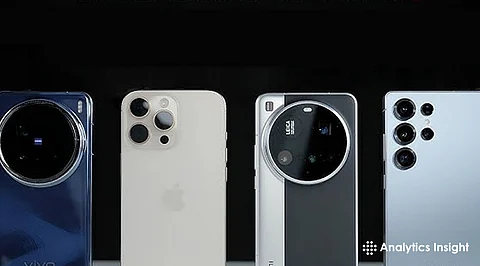

Flagship phones in 2025 are breaking records, and the Xiaomi 15 Ultra, Vivo X200 Pro, and Samsung Galaxy S25 Ultra are among the giants in the market. They each offer different strengths: camera dominance, processing power, and design talent, racing to be better than the other.
They all have different strengths: camera superiority, processor power, and design excellence; competing with one another to outperform each other. It is concerning their specs, price, and what makes them different, remembering that they excel in an industry where there are too many choices.
Physical attractiveness differs among these rivals. The Xiaomi 15 Ultra boasts a slim 6.73-inch frame with a vegan leather and aluminium dual-tone coating, which is premium but also easy to grip. Its IP68 rating guarantees dust and water resistance, but its top-heavy camera island compromises balance to some extent. The Vivo X200 Pro, measuring 6.78 inches, features a glass back and aluminium frame, both IP68 and IP69 certified for extra water jet resistance.
Its quad-curved display is an added visual appeal. In contrast, the Samsung Galaxy S25 Ultra, with its maximum size of 6.9 inches, uses a titanium-glass sandwich with curved sides, also IP68-rated. Its inclusion of an S Pen gives it a functional twist, but its sharper corners conflict with the smoother sides of others.
Screen quality defines the user experience. The Xiaomi 15 Ultra features a 6.73-inch LTPO AMOLED with 1440 x 3200 resolution, hitting 3,200 nits peak brightness for vivid outdoor visibility. Its 120Hz refresh rate guarantees smooth scrolling. The Vivo X200 Pro responds with a 6.78-inch LTPO AMOLED at 2800 x 1260, featuring a whopping 4,500 nits - perfect for HDR material; along with a quad-curved design for immersion.
The Samsung Galaxy S25 Ultra presents a 6.9-inch Dynamic AMOLED 2X, matching Xiaomi's 3120 x 1440 resolution and outputting 2,600 nits. Its flat panel puts functionality first, with adaptive 120Hz ensuring animations remain silky smooth.
Muscle processing powers these flagships. The Xiaomi 15 Ultra is powered by the Qualcomm Snapdragon 8 Elite, a 3nm chip operating at 4.32 GHz, coupled with 16GB LPDDR5X RAM and UFS 4.1 storage (512GB). This setup excels in gaming and multitasking. The Vivo X200 Pro runs on the MediaTek Dimensity 9400, another 3nm powerhouse, with 16GB RAM and UFS 4.0 storage (512GB), optimized for AI tasks and efficiency.
The Samsung Galaxy S25 Ultra also uses a Snapdragon 8 Elite variant, tuned “for Galaxy,” with 12GB RAM and up to 1TB UFS 4.0 storage. Benchmarks suggest near-identical real-world speed, though Samsung’s overclocked CPU edges out in raw compute tests.
Photography remains a battleground. The Xiaomi 15 Ultra wields a Leica-tuned quad setup: a 50MP 1-inch main sensor, a 50MP ultra-wide, a 50MP 3x telephoto, and a 200MP 4.3x periscope. Its night and zoom capabilities are excellent. Vivo X200 Pro, with Zeiss lenses, has a 50MP main, 50MP ultra-wide, and 200MP 3.7x periscope three-camera setup, which excels in night photography and video stabilization.
Samsung Galaxy S25 Ultra features a 200MP main, 50MP ultra-wide, 10MP 3x tele, and 50MP 5x periscope quad-camera setup, with up to 100x digital zoom flexibility, though its processing is not as smooth as rivals. All support 8K video, with Vivo adding Dolby Vision.
Endurance matters in daily use. The Xiaomi 15 Ultra packs a 5,410mAh battery with 90W wired and 80W wireless charging, charger included. The Vivo X200 Pro leads with a 6,000mAh cell, matching 90W wired and adding 30W wireless, also bundled with a charger. The Samsung Galaxy S25 Ultra sticks to 5,000mAh, with 45W wired and 15W wireless (Qi2-ready), but no charger in the box. Vivo’s capacity promises longer runtime, though all deliver over 8 hours of screen-on time under heavy use.
Cost influences decisions. The Xiaomi 15 Ultra is available for ₹1,09,999 (circa $1,300) for 16GB/512GB, exported to India and certain international regions. The Vivo X200 Pro at ₹94,999 (circa $1,050) competes with rivals in similar features but in select international regions. The Samsung Galaxy S25 Ultra starts at ₹1,29,999 (circa $1,299) for 12GB/256GB and enjoys wider regional availability through channels operated by Samsung globally. Differential pricing reflects geographic strategy and product positioning.
Xiaomi 15 Ultra, Vivo X200 Pro, and Samsung Galaxy S25 Ultra each cater to different priorities. Zoom users will be drawn to Xiaomi or Vivo's performance in low light, while Samsung's ecosystem and S Pen will be attractive to productivity fans. Specifications tilt in favour of Vivo for battery, Xiaomi for the screen, and Samsung for software support longevity. Leadership in the market relies on innovating and providing value too, each does this well, but none can wear a crown in every regard.
